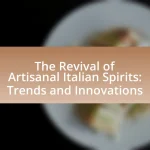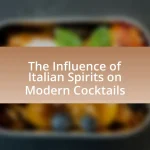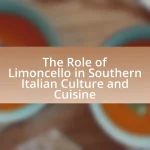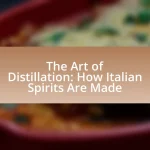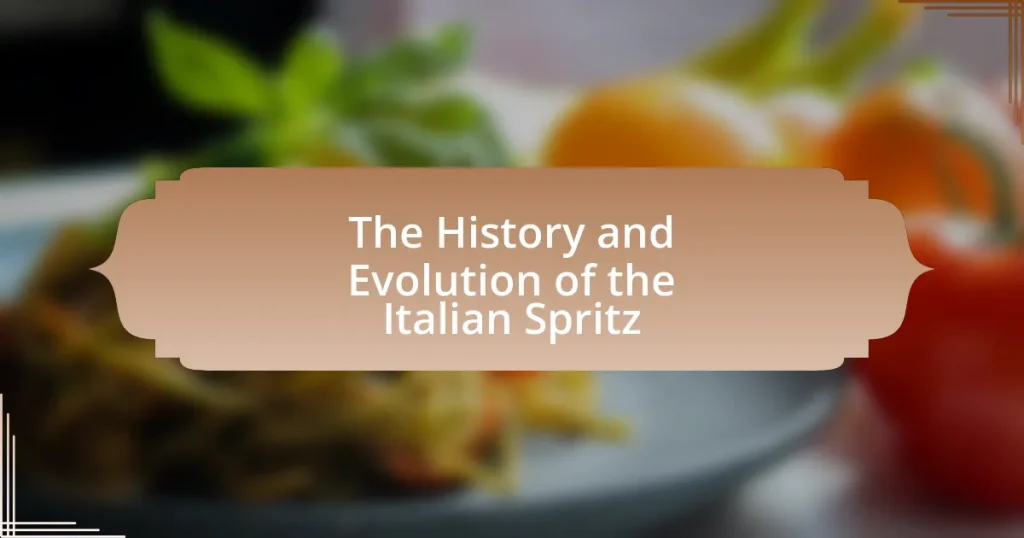The Italian Spritz is a renowned cocktail that originated in the Veneto region of Italy during the 19th century, initially created as a lighter version of local wines by adding soda water. This article explores the historical influences that shaped the Spritz, including its evolution from a simple wine and water mix to a popular aperitif featuring ingredients like Prosecco, Aperol, and Campari. It also examines the significance of the Spritz in Italian culture, its role in social gatherings, and how modern trends and globalization have impacted its presentation and variations. Additionally, the article highlights contemporary innovations in serving the Spritz and the influence of social media on its popularity.
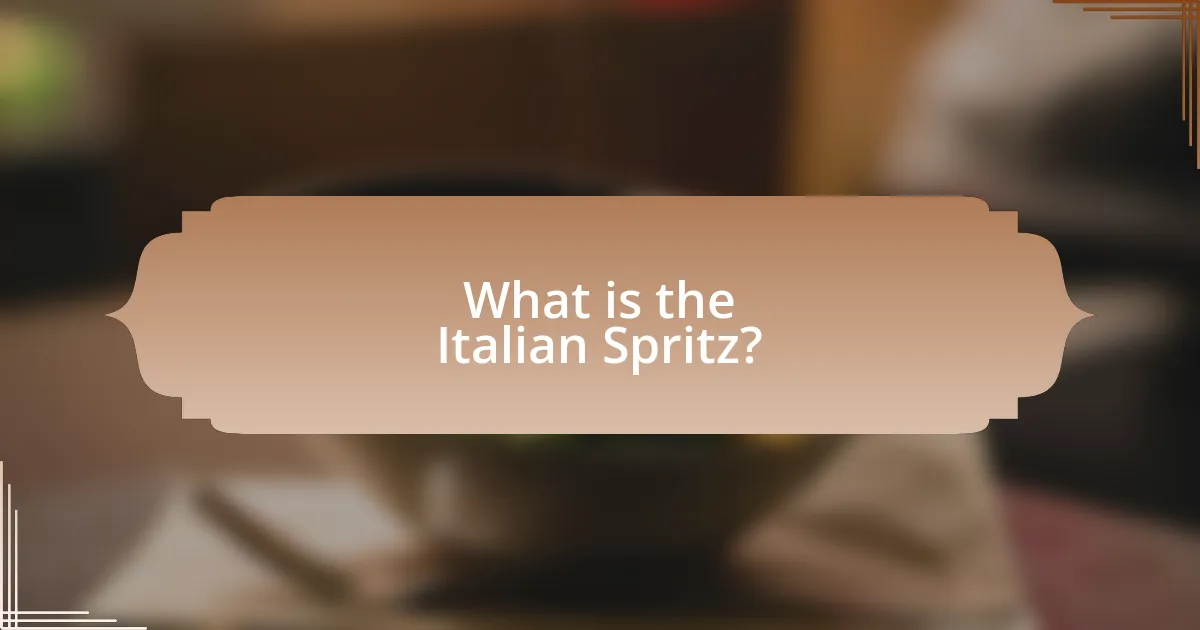
What is the Italian Spritz?
The Italian Spritz is a popular cocktail originating from Italy, typically made with Prosecco, Aperol or Campari, and soda water. This refreshing drink is characterized by its vibrant orange color and bittersweet flavor profile. The Spritz has historical roots dating back to the 19th century in the Veneto region, where it was initially created as a lighter version of wine by adding soda water to local wines. Over time, the drink evolved, with the introduction of Aperol in the 1919, which became a key ingredient, solidifying the Spritz’s status as a quintessential Italian aperitif.
How did the Italian Spritz originate?
The Italian Spritz originated in the Veneto region of Italy during the 19th century. Initially, it was a simple mix of wine and water, created by Austrian soldiers who found the local wines too strong. Over time, the drink evolved to include various ingredients, such as Aperol or Campari, which were added to enhance flavor and color. This transformation solidified the Spritz as a popular aperitif, particularly in Venice, where it became a staple of social gatherings and local culture.
What historical influences shaped the creation of the Italian Spritz?
The Italian Spritz was shaped by historical influences including the Austrian occupation of Venice in the 19th century, which introduced the practice of mixing local wines with water or soda to create a lighter beverage. This practice evolved into the Spritz, characterized by the addition of bitter liqueurs like Aperol or Campari, which became popular in the early 20th century. The combination of these elements reflects the cultural exchange between Italian and Austrian traditions, leading to the modern Spritz enjoyed today.
Which regions in Italy are most associated with the Spritz?
The regions in Italy most associated with the Spritz are Veneto and Friuli Venezia Giulia. Veneto, particularly the city of Venice, is recognized as the birthplace of the Spritz, where the drink originated in the 19th century. Friuli Venezia Giulia also plays a significant role in the drink’s popularity, as it shares cultural and historical ties with Veneto, contributing to the drink’s evolution and variations.
What are the key ingredients of the Italian Spritz?
The key ingredients of the Italian Spritz are Prosecco, Aperol or Campari, and soda water. Prosecco, an Italian sparkling wine, serves as the base, while Aperol or Campari adds a distinctive bitter flavor. Soda water is then added to lighten the drink and enhance its refreshing qualities. This combination creates a balanced cocktail that has become popular in Italian aperitivo culture.
How do different ingredients affect the flavor profile of the Spritz?
Different ingredients significantly influence the flavor profile of the Spritz by altering its sweetness, bitterness, and overall complexity. For instance, the use of Aperol introduces a sweet and slightly bitter orange flavor, while Campari adds a more pronounced bitterness and herbal notes. The choice of sparkling wine, such as Prosecco, contributes a crisp and fruity element, enhancing the drink’s refreshing quality. Additionally, the inclusion of soda water balances the flavors, providing a light and effervescent finish. Historical variations of the Spritz, such as those made with white wine or different bitters, further demonstrate how ingredient substitutions can create distinct flavor experiences, reflecting regional preferences and evolving tastes.
What variations of the Spritz exist based on ingredient choices?
Variations of the Spritz exist primarily based on the choice of base ingredients, which can include different types of aperitifs and sparkling wines. Common variations include the Aperol Spritz, which uses Aperol as the aperitif, and the Campari Spritz, which substitutes Campari for a more bitter flavor. Additionally, the use of different sparkling wines, such as Prosecco or other regional sparkling wines, can alter the drink’s profile. The choice of garnishes, such as orange slices or olives, also contributes to the diversity of Spritz variations.
Why is the Italian Spritz significant in Italian culture?
The Italian Spritz is significant in Italian culture as it embodies the social and leisurely lifestyle of Italians, particularly in the Veneto region. This cocktail, traditionally made with Prosecco, Aperol, and soda water, serves as a symbol of conviviality and relaxation, often enjoyed during aperitivo hours. The practice of aperitivo, which dates back to the 18th century, emphasizes socializing and unwinding before dinner, making the Spritz a cultural staple. Its popularity has grown internationally, yet it remains deeply rooted in Italian customs, reflecting the importance of community and shared experiences in Italian life.
What role does the Spritz play in social gatherings and traditions?
The Spritz serves as a central element in social gatherings and traditions, particularly in Italian culture. This refreshing cocktail, typically made with Prosecco, Aperol or Campari, and soda water, is often enjoyed during aperitivo hours, which are social occasions that encourage relaxation and conversation before dinner. Historically, the Spritz has roots in the Veneto region, where it became popular in the 19th century as a way to enhance local wines and facilitate social interaction. Its vibrant color and light flavor profile make it a favored choice for celebrations, outdoor gatherings, and festive occasions, reinforcing its role as a symbol of conviviality and community in Italian traditions.
How has the perception of the Spritz evolved over time in Italy?
The perception of the Spritz in Italy has evolved from a regional aperitif to a globally recognized cocktail. Initially, the Spritz was a simple mix of wine and water, popular in the Veneto region during the 19th century, primarily consumed by locals. Over time, particularly from the 20th century onwards, the drink transformed with the addition of bitters and soda, leading to the modern Spritz we know today, often made with Aperol or Campari. This evolution reflects broader cultural shifts, as the Spritz became associated with socializing and leisure, gaining popularity in urban centers and eventually becoming a staple in bars worldwide. The rise of social media and cocktail culture has further propelled its status, making it a symbol of Italian lifestyle and sophistication.
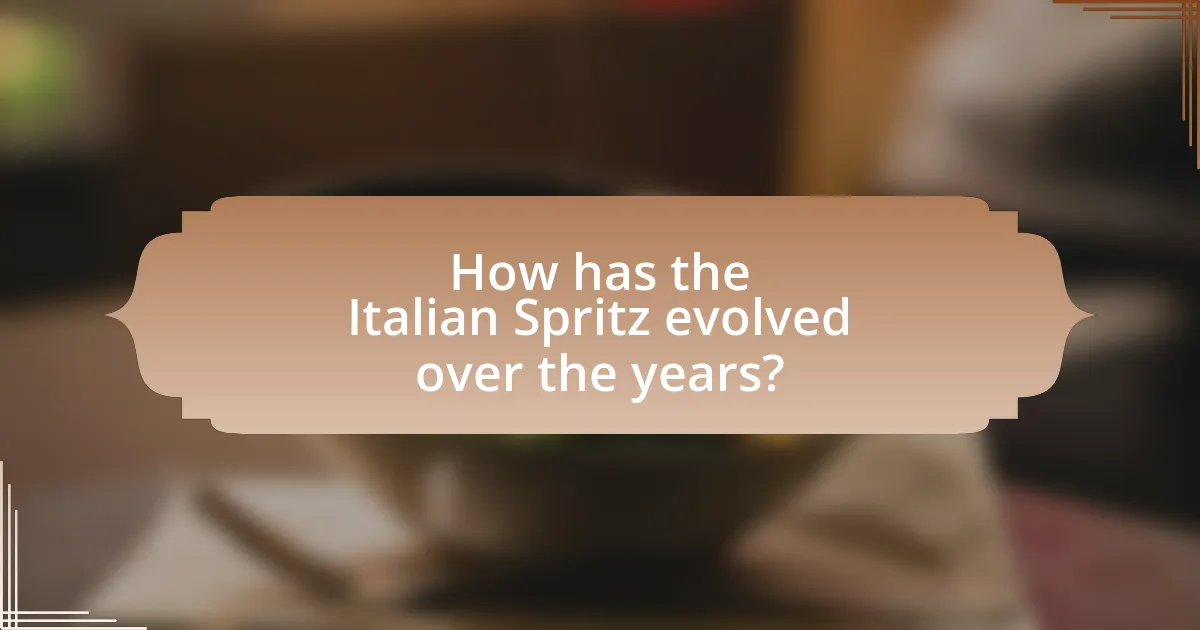
How has the Italian Spritz evolved over the years?
The Italian Spritz has evolved significantly from its origins in the 19th century, transitioning from a simple wine and soda mix to a globally recognized cocktail. Initially, the Spritz was a blend of white wine and water, popularized in the Veneto region, where Austrian soldiers would dilute local wines with soda to make them more palatable. Over the years, the introduction of Aperol in the early 20th century transformed the drink, adding a vibrant orange hue and a bittersweet flavor profile. By the 2000s, the Spritz gained international popularity, with variations incorporating different aperitifs like Campari and Select, leading to a diverse range of recipes. This evolution reflects broader trends in cocktail culture, where the Spritz has become synonymous with social gatherings and outdoor dining, particularly in summer months.
What major changes have occurred in the recipe of the Italian Spritz?
The major changes in the recipe of the Italian Spritz include the shift from using only white wine and soda water to incorporating various aperitifs, such as Aperol and Campari, which add distinct flavors and colors. Historically, the original Spritz was a simple mix of wine and water, but over time, particularly since the 2000s, the introduction of these flavored liqueurs has transformed the drink into a more complex and visually appealing cocktail. This evolution reflects broader trends in cocktail culture, where flavor innovation and presentation have become increasingly important.
How have modern trends influenced the traditional Spritz recipe?
Modern trends have significantly influenced the traditional Spritz recipe by introducing innovative ingredients and variations that cater to contemporary tastes. For instance, the classic Spritz, typically made with Prosecco, Aperol, and soda water, has seen adaptations using different bitters like Campari or even non-alcoholic alternatives to appeal to a broader audience. Additionally, the rise of craft cocktails has led to the incorporation of fresh herbs, fruits, and artisanal mixers, enhancing the flavor profile and presentation of the drink. This evolution reflects a growing consumer preference for personalized and visually appealing beverages, as evidenced by the increasing popularity of Instagram-worthy cocktails in bars and restaurants.
What impact has globalization had on the popularity of the Spritz?
Globalization has significantly increased the popularity of the Spritz, transforming it from a regional Italian beverage into a global cocktail phenomenon. The rise of international travel and social media has facilitated the sharing of cultural practices, allowing the Spritz to be featured in bars and restaurants worldwide, particularly in urban centers. For instance, the cocktail gained traction in cities like New York and London, where Italian cuisine and culture are celebrated. Additionally, the global trend towards aperitivo culture, which emphasizes socializing over drinks before dinner, has further propelled the Spritz into mainstream consciousness, making it a staple in many cocktail menus across various countries.
How has the presentation of the Italian Spritz changed?
The presentation of the Italian Spritz has evolved from a simple, rustic drink served in basic glassware to a more sophisticated cocktail presented in stylish, oversized wine glasses. Initially, the Spritz was a straightforward mix of wine and soda, often served in small tumblers, but contemporary variations emphasize aesthetics, incorporating garnishes like orange slices and herbs, and utilizing vibrant colors from different aperitifs. This shift reflects broader trends in cocktail culture, where visual appeal and presentation have become crucial, as evidenced by the rise of social media platforms showcasing beautifully crafted drinks.
What are the current trends in serving and garnishing the Spritz?
Current trends in serving and garnishing the Spritz include the use of unique garnishes such as fresh herbs, edible flowers, and seasonal fruits to enhance visual appeal and flavor. Bartenders are increasingly opting for high-quality, artisanal ingredients, including craft bitters and premium sparkling wines, to elevate the drink’s overall quality. Additionally, variations like the Spritz Bianco, which uses white wine instead of the traditional Prosecco, are gaining popularity, reflecting a shift towards lighter, more refreshing options. These trends are supported by the growing consumer interest in personalized and aesthetically pleasing cocktails, as evidenced by social media platforms showcasing visually striking drinks.
How do different establishments interpret the presentation of the Spritz?
Different establishments interpret the presentation of the Spritz in varied ways, reflecting regional preferences and branding strategies. For instance, traditional Venetian bars often serve the Spritz in a large wine glass with a bright orange hue, garnished with an olive or a slice of orange, emphasizing its origins in Venice. In contrast, modern cocktail bars may present the Spritz in a more stylized manner, using unique glassware and creative garnishes, such as herbs or exotic fruits, to appeal to contemporary aesthetics. This variation in presentation not only highlights the Spritz’s adaptability but also showcases the establishment’s identity and target audience, with some prioritizing authenticity while others focus on innovation.
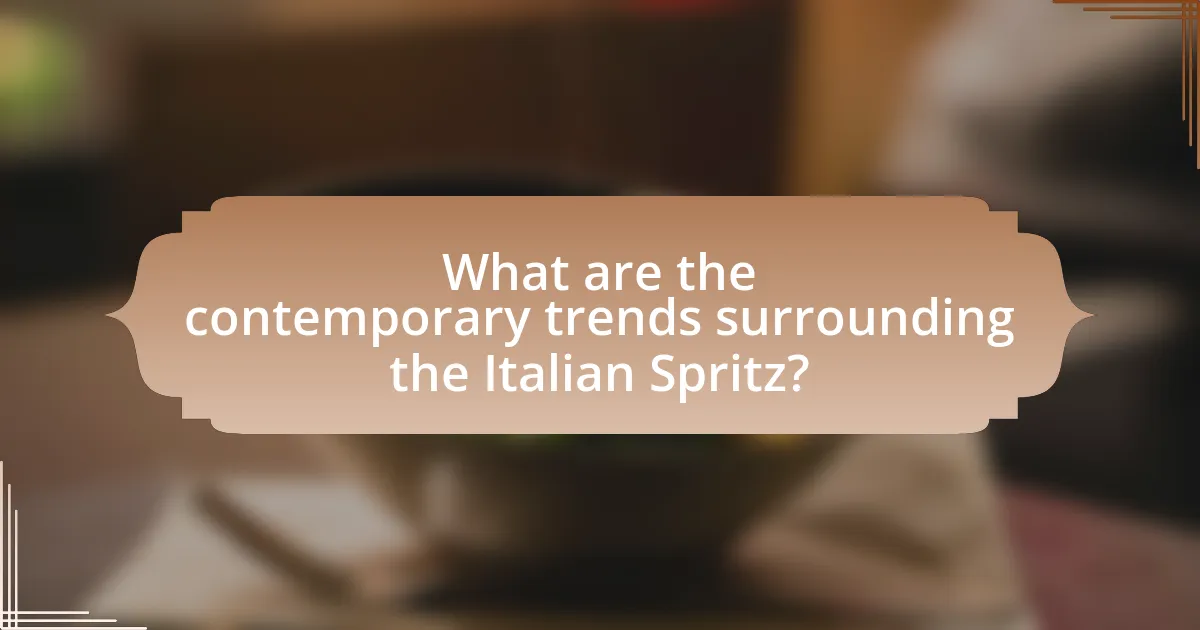
What are the contemporary trends surrounding the Italian Spritz?
Contemporary trends surrounding the Italian Spritz include a growing emphasis on artisanal ingredients and innovative variations of the classic recipe. Many bars and restaurants are now using high-quality, locally sourced spirits and fresh ingredients, such as seasonal fruits and herbs, to create unique twists on the traditional Aperol Spritz. Additionally, there is an increasing popularity of low-alcohol cocktails, with the Spritz being a favored choice due to its refreshing nature and lower alcohol content compared to other cocktails. This trend aligns with a broader movement towards mindful drinking, where consumers are more conscious of their alcohol intake. Furthermore, social media platforms have played a significant role in popularizing visually appealing Spritz variations, leading to a surge in creative presentations and garnishes that enhance the drink’s aesthetic appeal.
How is the Italian Spritz being marketed today?
The Italian Spritz is being marketed today through a combination of social media campaigns, influencer partnerships, and experiential marketing events. Brands like Aperol and Campari leverage platforms such as Instagram and TikTok to showcase visually appealing content that highlights the drink’s vibrant colors and social aspects, targeting younger demographics. Additionally, pop-up bars and festivals featuring the Spritz create immersive experiences that engage consumers directly, reinforcing its image as a trendy, refreshing beverage. This marketing strategy is supported by the growing popularity of aperitivo culture, which emphasizes socializing and enjoying drinks in a relaxed setting, further driving consumer interest and sales.
What role do social media and influencers play in promoting the Spritz?
Social media and influencers play a crucial role in promoting the Spritz by leveraging their platforms to showcase the drink’s vibrant culture and lifestyle. Influencers often share visually appealing content featuring the Spritz, which enhances its desirability and aligns it with social experiences. For instance, a study by the Digital Marketing Institute found that 49% of consumers depend on influencer recommendations for their purchasing decisions, indicating that influencers significantly impact consumer behavior regarding trendy beverages like the Spritz. Additionally, social media campaigns often utilize hashtags and challenges that encourage user-generated content, further amplifying the drink’s visibility and popularity among younger demographics.
How are bars and restaurants innovating with the Spritz experience?
Bars and restaurants are innovating with the Spritz experience by introducing unique flavor combinations and presentation styles. Establishments are experimenting with various base spirits, such as gin or tequila, alongside traditional ingredients like Aperol or Campari, to create signature Spritz variations that appeal to diverse palates. Additionally, many venues are enhancing the visual appeal of the drink by incorporating fresh herbs, edible flowers, and artisanal garnishes, which not only elevate the aesthetic but also enhance the overall sensory experience. This trend reflects a broader movement in the beverage industry towards personalization and creativity, as seen in the rise of craft cocktails, where customization and unique presentations are key to attracting customers.
What are some popular variations of the Italian Spritz today?
Some popular variations of the Italian Spritz today include the Aperol Spritz, Campari Spritz, and Select Spritz. The Aperol Spritz, made with Aperol, Prosecco, and soda water, is the most widely recognized variation, known for its bright orange color and bittersweet flavor. The Campari Spritz substitutes Campari for Aperol, offering a more intense and bitter taste, while the Select Spritz uses Select, a Venetian aperitif, which adds a unique herbal profile. These variations reflect the evolving preferences for different flavor profiles in the classic Spritz cocktail.
How do these variations reflect regional tastes and preferences?
Variations of the Italian Spritz reflect regional tastes and preferences by incorporating local ingredients and flavors that resonate with the cultural identity of each area. For instance, in Venice, the traditional Spritz is made with Aperol, while in the northern regions, it may feature Campari, showcasing a preference for bolder, more bitter flavors. Additionally, the use of local wines, such as Prosecco in the Veneto region, highlights the importance of regional wine production and its influence on local cocktail culture. This adaptability of the Spritz to regional ingredients illustrates how local customs and available resources shape beverage preferences across Italy.
What are the most common ingredients used in modern Spritz variations?
The most common ingredients used in modern Spritz variations include prosecco, bitter liqueurs such as Aperol or Campari, and soda water. Prosecco serves as the base, providing a sparkling and refreshing quality, while bitter liqueurs add complexity and flavor, with Aperol being sweeter and Campari offering a more intense bitterness. Soda water is typically added to lighten the drink and enhance its effervescence. These ingredients reflect the traditional Spritz recipe, which has evolved to include various adaptations while maintaining the core components that define the cocktail.
What tips can enhance the experience of enjoying an Italian Spritz?
To enhance the experience of enjoying an Italian Spritz, serve it over ice in a large wine glass, as this allows for optimal dilution and temperature control. The traditional ratio of three parts Prosecco, two parts Aperol or Campari, and one part soda water should be followed for a balanced flavor profile. Additionally, garnishing with a slice of orange or an olive adds a fresh aroma and visual appeal, enhancing the overall sensory experience. Research indicates that serving cocktails in appropriate glassware can significantly impact the perception of taste and enjoyment, making the choice of glass crucial for an authentic experience.

